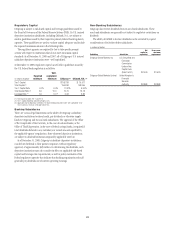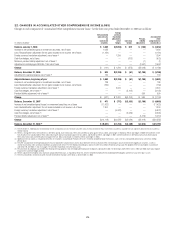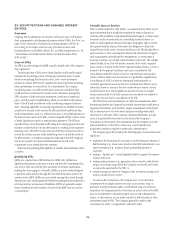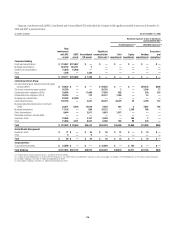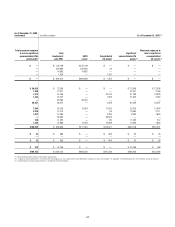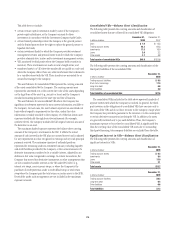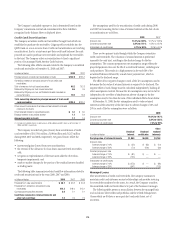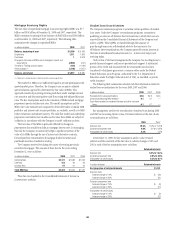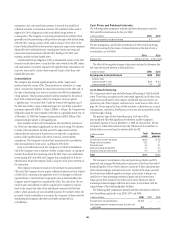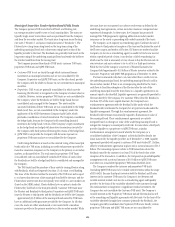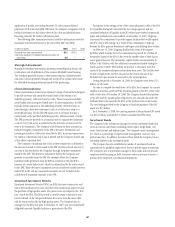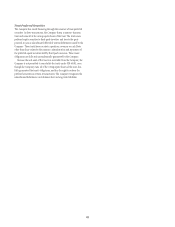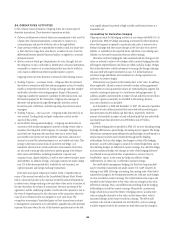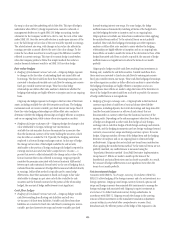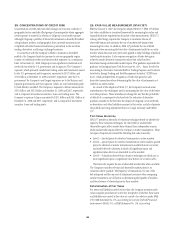Citibank 2008 Annual Report Download - page 189
Download and view the complete annual report
Please find page 189 of the 2008 Citibank annual report below. You can navigate through the pages in the report by either clicking on the pages listed below, or by using the keyword search tool below to find specific information within the annual report.
On-Balance Sheet Securitizations
The Company engages in on-balance sheet securitizations. These are
securitizations that do not qualify for sales treatment; thus, the assets remain
on the Company’s balance sheet. The following table presents the carrying
amounts and classification of consolidated assets and liabilities transferred
in transactions from the consumer credit card, student loan, mortgage and
auto businesses, accounted for as secured borrowings:
In billions of dollars
December 31,
2008
December 31,
2007
Cash $ 0.3 $ 0.1
Available-for-sale securities 0.1 0.2
Loans 7.5 7.4
Allowance for loan losses (0.1) (0.1)
Total assets $ 7.8 $ 7.6
Long-term debt $ 6.3 $ 5.8
Other liabilities 0.3 0.4
Total liabilities $ 6.6 $ 6.2
All assets are restricted from being sold or pledged as collateral. The cash
flows from these assets are the only source used to pay down the associated
liabilities, which are non-recourse to the Company’s general assets.
Citi-Administered Asset-Backed Commercial Paper Conduits
The Company is active in the asset-backed commercial paper conduit
business as administrator of several multi-seller commercial paper conduits,
and also as a service provider to single-seller and other commercial paper
conduits sponsored by third parties.
The multi-seller commercial paper conduits are designed to provide the
Company’s customers access to low-cost funding in the commercial paper
markets. The conduits purchase assets from or provide financing facilities to
customers and are funded by issuing commercial paper to third-party
investors. The conduits generally do not purchase assets originated by the
Company. The funding of the conduit is facilitated by the liquidity support
and credit enhancements provided by the Company and by certain third
parties. As administrator to the conduits, the Company is responsible for
selecting and structuring of assets purchased or financed by the conduits,
making decisions regarding the funding of the conduits, including
determining the tenor and other features of the commercial paper issued,
monitoring the quality and performance of the conduits’ assets, and
facilitating the operations and cash flows of the conduits. In return, the
Company earns structuring fees from clients for individual transactions and
earns an administration fee from the conduit, which is equal to the income
from client program and liquidity fees of the conduit after payment of
interest costs and other fees. This administration fee is fairly stable, since
most risks and rewards of the underlying assets are passed back to the
customers and, once the asset pricing is negotiated, most ongoing income,
costs and fees are relatively stable as a percentage of the conduit’s size.
The conduits administered by the Company do not generally invest in
liquid securities that are formally rated by third parties. The assets are
privately negotiated and structured transactions that are designed to be held
by the conduit, rather than actively traded and sold. The yield earned by the
conduit on each asset is generally tied to the rate on the commercial paper
issued by the conduit, thus passing interest rate risk to the client. Each asset
purchased by the conduit is structured with transaction-specific credit
enhancement features provided by the third-party seller, including over-
collateralization, cash and excess spread collateral accounts, direct recourse
or third-party guarantees. These credit enhancements are sized with the
objective of approximating a credit rating of A or above, based on the
Company’s internal risk ratings.
Substantially all of the funding of the conduits is in the form of short-
term commercial paper. As of December 31, 2008, the weighted average life
of the commercial paper issued was approximately 37 days. In addition, the
conduits have issued Subordinate Loss Notes and equity with a notional
amount of approximately $80 million and varying remaining tenors
ranging from six months to seven years.
The primary credit enhancement provided to the conduit investors is in
the form of transaction-specific credit enhancement described above. In
addition, there are two additional forms of credit enhancement that protect
the commercial paper investors from defaulting assets. First, the Subordinate
Loss Notes issued by each conduit absorb any credit losses up to their full
notional amount. It is expected that the Subordinate Loss Notes issued by
each conduit are sufficient to absorb a majority of the expected losses from
each conduit, thereby making the single investor in the Subordinate Loss
Note the primary beneficiary under FIN 46(R). Second, each conduit has
obtained a letter of credit from the Company, which is generally 8-10% of the
conduit’s assets. The letters of credit provided by the Company total
approximately $5.8 billion and are included in the Company’s maximum
exposure to loss. The net result across all multi-seller conduits administered
by the Company is that, in the event of defaulted assets in excess of the
transaction-specific credit enhancement described above, any losses in each
conduit are allocated in the following order:
• Subordinate loss note holders
• the Company
• the commercial paper investors
The Company, along with third parties, also provides the conduits with
two forms of liquidity agreements that are used to provide funding to the
conduits in the event of a market disruption, among other events. Each asset
of the conduit is supported by a transaction-specific liquidity facility in the
form of an asset purchase agreement (APA). Under the APA, the Company
has agreed to purchase non-defaulted eligible receivables from the conduit at
par. Any assets purchased under the APA are subject to increased pricing. The
APA is not designed to provide credit support to the conduit, as it generally
does not permit the purchase of defaulted or impaired assets and generally
reprices the assets purchased to consider potential increased credit risk. The
APA covers all assets in the conduits and is considered in the Company’s
maximum exposure to loss. In addition, the Company provides the conduits
with program-wide liquidity in the form of short-term lending
commitments. Under these commitments, the Company has agreed to lend
to the conduits in the event of a short-term disruption in the commercial
paper market, subject to specified conditions. The total notional exposure
under the program-wide liquidity agreement is $11.3 billion and is
considered in the Company’s maximum exposure to loss. The Company
receives fees for providing both types of liquidity agreement and considers
these fees to be on fair market terms.
183


